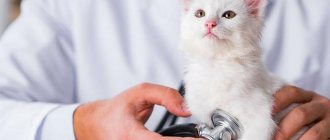Among the many parasites found in domestic animals, the leaders are helminths in the intestines. Roundworms in cats are a common and dangerous phenomenon because the worms do not immediately detect their presence. “Tenants” of the gastrointestinal tract bring a lot of trouble to animals and their owners, and this is a reason to understand this issue more deeply.
Roundworms in cats: symptoms and treatment
What are roundworms and what do they look like?
Roundworms that parasitize cats are roundworms that vary in size and gender. They live most often in the intestines, but are sometimes found in the pancreas, gall bladder, and other organs.
Appearance of cat roundworm
Three species of roundworms parasitize the digestive tract of domestic cats, and all of them are classified as representatives of the nematode suborder Ascaridata of the genus Ascaris. The pathology caused by the presence of nematodes in the body of cats is called toxocariasis.
The causative agents of toxocariasis differ morphologically and also externally.
Table 1. Types of roundworms
| Name | Appearance Features |
Toxocara cati | Light yellow worms, the males of which are up to 5 cm in length, and the females are twice as large. The eggs are brown, spherical in shape, with a thick and rough wall. Their sizes are up to 65×75 microns |
| Toxocara leonina | Yellow helminths, from 6 to 10 cm in length. Eggs are smooth, thick-walled, oval or round, with a diameter of up to 80 microns |
Toxacara canis | Large gray-yellow worms with a length of 94 to 18 cm. In males, the tail is curved. The parasite lays eggs of a round shape, gray in color, in which the cellularity is clearly visible |
What are the symptoms of infection in dogs?
Roundworms will be especially dangerous to the health of puppies.
Infection manifests itself as follows:
- Malnutrition. Roundworms parasitize the intestines, depriving the puppy of nutrients. This is accompanied by weakness, weight loss, and growth retardation.
- Potbelliness. Parasites can multiply so quickly that their numbers give the puppy a pot-bellied appearance.
- Cough. The larvae can enter the lungs, causing airway irritation and respiratory symptoms. In severe stages of infection, this can lead to pneumonia.
- Vomiting or diarrhea. Worms often cause indigestion. Owners can detect helminths in the contents of vomit or stool.
The life cycle of helminths as a mechanism for the development of toxocariasis
On average, a month passes from the release of the parasite egg to its sexual maturity. During this time, a larva is born, which soon grows into an adult and, in turn, begins to reproduce, releasing a huge number of eggs.
Toxocara cati
For these intestinal worms, cats act as definitive hosts. At the intermediate stage, parasites live in the bodies of mice, chickens, beetles and earthworms, where they do not spend a full life cycle, but only survive a certain period. It is believed that vectors play the role of a “vehicle”.
Long-term presence of parasites in a cat’s body disables its internal organs.
The main part of the life of Toxocara cati takes place in the body of a cat. The eggs laid by the parasite enter the digestive tract of the small predator, where larvae (0.31 - 0.42 mm in length) emerge from them. Through the intestinal walls they enter the bloodstream, which spreads this infection throughout the body. Such migration causes problems with the functioning of the organs and systems of the host animal.
Toxocara cati eggs
Localized in the respiratory system, the larvae are released from there with sputum, but are swallowed again, after which they re-enter the gastrointestinal tract and settle there. In the cavity of the small intestine, the worm forms into a sexually mature individual.
In one day, the female Toxocara cati releases a colossal number of eggs, which enter the external environment with the host’s feces. 1 g of feces from a sick animal contains more than 100 thousand “containers” with future parasites.
Toxacara canis
Parasites of this type are typical for dogs, but are often found in cats. A visual representation of the life cycle of the nematode Toxacara canis is provided by the example of eggs entering the body of a pregnant cat. The animal receives them from contaminated food. Once in the digestive system, they eventually penetrate the blood and spread throughout the body, affecting organs and tissues.
Egg of Toxacara canis
Hormones secreted in the body of a pregnant cat stimulate the active growth of larvae. Later, some of them are localized in the uterus and mammary gland tissues, while others continue to live and develop in the intestines of the female.
Kittens born from a mother infected with worms inevitably inherit them.
Worms that infect the uterus penetrate the kittens’ body long before they are born, and transform into sexually mature helminths when the kitten is half a month old. Cat offspring can get Toxocara canis through mother's milk, through licking by the mother cat, as well as through contact with her fur where there are traces of feces with helminth eggs. As for the female, she becomes infected for the second time when licking kittens.
Through licking, both the kitten and the cat exchange parasites again
Worms and their larvae can infect the liver and lungs, causing dysfunction of these organs. Some individuals continue their life activities in the digestive tract. They actively reproduce, destroying the host’s body. From time to time, helminths and their eggs are excreted in the feces, where they remain until they enter the body of a new host.
Toxocara leonina
This type of parasite is characterized by having the simplest life cycle among roundworms. Larvae emerge from eggs swallowed by a cat and grow in the small intestine.
Toxocara leonina eggs
Adult Toxocara leonina lay eggs, which are excreted from the host in feces. Once in the gastrointestinal tract of the following animals, they give birth to larvae, and everything repeats all over again.
Hunting for mice is fraught with infection by parasites
Mice can be carriers of helminths. Larvae emerge from the eggs that find themselves in the digestive tract of rodents. When a furry predator eats such a mouse, the worms enter the cat's intestines, where their development continues.
How dangerous is ascariasis for cats?
Roundworms in cats cause the chronic disease toxocariasis.
In principle, even the name “roundworms” for roundworms that parasitize the body of cats and dogs is not entirely accurate. Toxocara leonina, Toxocara mystax, Toxacara catti live in the intestines of cats and dogs. You can see how they look in the photo. These parasites belong to the general suborder of roundworms (nematodes) Ascaridata of the genus Ascaris. It has been clinically proven that roundworms in cats and dogs cannot cause helminthic infestation in humans.
Dog or cat roundworm eggs will not be able to develop in the human body, even if they are purposefully “planted” there. This is due to the fact that human roundworm develops in the intestines at a temperature of 36.6 degrees, and roundworms of cats and dogs develop at a temperature of 38.5 - 39 degrees.
A person can become infected with other worms from animals, so pets need to undergo a full course of deworming once every 3 months, and if a helminthic infestation is diagnosed, they need adequate treatment.
Ways of infection of pets
Even if your pets are constantly at home, the possibility of ascariasis in cats cannot be ruled out. An animal may “just for a second” jump out onto the landing, or may sniff and lick your outdoor shoes, which almost always contain worm eggs.
Puppies and kittens can ingest eggs in their mother's milk or become infected in utero from a sick mother. Before mating, animals must undergo anthelmintic treatment.
With the feces of a sick animal, fertilized eggs of parasites fall into the soil, where, under favorable conditions, the maturation process occurs. Microscopic mature worm eggs are carried by flies, ants, and shoes. Gusts of wind during drafts, along with dust, can be carried into the apartment through open windows. It is noteworthy that in direct sunlight the eggs die within a couple of hours, but they can tolerate frost down to -25 degrees, just being on the surface of the earth.
Only regular wet cleaning, disinfection of trays, maintaining a sanitary culture of housing, regular deworming and proper treatment can protect pets from parasites.
How do roundworms develop in animals?
A mature roundworm egg is covered with a shell, inside of which there is a microscopic, coiled parasite. You can see what it looks like in the photo. After ingestion, the lining in the stomach dissolves and this parasite begins to migrate in the body of animals. The larvae of Toxocara mystax and Toxacara catti pierce the intestinal walls, penetrate the circulatory system, and enter the liver and lungs through the bloodstream. There they develop over 12-20 days, causing coughing and sometimes vomiting in cats and dogs. When coughing with sputum, the larvae enter the oral cavity, are swallowed and enter the intestines, where they permanently live.
Our readers recommend! For the prevention and treatment of parasitic infestations, our readers recommend the Bactefort parasite remedy. It consists exclusively of medicinal plants collected in environmentally friendly places, which are extremely effective in cleansing the body of parasites, and also heal and protect the body as a whole. Doctors' opinion..."
The larvae of Toxocara leonina, injuring the intestinal walls, penetrate deeply into them, where they remain for 10-12 days until they become sexually mature. After this, they crawl inside the intestines, where they remain until their death, poisoning their owner with the decay products of the parasite.
Treatment must be carried out in several stages to kill adults and larvae.
Larvae and adult parasites cause serious damage to internal organs, so to save the lives of cats and dogs, it is necessary to start treatment on time.
Symptoms of the disease
Signs of ascariasis in cats:
- Digestive disorders, vomiting, diarrhea;
- Pneumonia;
- The animal practically does not gain weight, the cats look thin and emaciated;
- Pale nose, tongue, sour eyes, tousled dull fur;
- Itching of the anus.
In dogs, the main signs of ascariasis are:
- Insatiable appetite. Despite regular, adequate feeding, the animal greedily “swallows” food;
- Intestinal disorders, diarrhea, constipation, sometimes vomiting;
- The abdomen is unnaturally distended with gases;
- The coat is dull, “lifeless”;
- The breath has a sweetish odor;
- Coughing, the animal makes sounds as if clearing its throat.
With severe helminthic infestation, parasites can cause intestinal obstruction, in some cases even rupture of the walls of the small intestine, which will inevitably lead to the death of the animal.
How dangerous is ascariasis for pets?
Ascariasis in cats and dogs causes severe consequences in animals:
- Mechanically – traumatic. The larvae burrow into the intestines, lungs, liver, pancreas, capillaries, causing internal bleeding, abscesses and necrosis of internal organs;
- Toxic – sensitizing. Larvae and adult parasites poison the body of cats and dogs with their waste products and cause allergic reactions;
- Exhausting. Parasites literally suck out all the beneficial components of food. As a result, animals do not receive enough vitamins and minerals, which causes retardation in growth and development. Animals are constantly lethargic, sick, and have a pitiful appearance.
It is impossible to make a diagnosis on your own; if ascariasis is suspected, it is necessary to undergo examination and appropriate treatment.
We are responsible for those whom we take into our home. While living with us, animals should receive our love and adequate treatment when necessary.
Author – Volochaev T. N.
glistenme.com>
Danger to humans
Nematodes that infect cats are also dangerous to humans. The degree of harm from their exposure largely depends on the state of the immune system, but in any case, their presence in the body does not pass without leaving a trace.
No matter how homely and sterile your pet is, you should not forget about the rules of hygiene
Infection occurs through the entry of helminth eggs from a pet into the owner’s mouth, and then into his gastrointestinal tract. This can happen if the owner does not wash his hands after:
- stroked a sick animal;
- empty the contents of the tray;
- touched the animal's bowls and toys;
- let the cat lick his hands.
The closer your relationship with your pet, the higher the risk of one day becoming infected with parasites.
In addition, the risk of invasion is high when a person:
- allows the pet to lick its face;
- kisses an animal;
- finishes food that the cat sniffed from her hands (touched with her nose, lips or tongue), but did not eat.
Toxocariasis is especially dangerous for people with weakened immune systems: patients, children and the elderly. In severe cases, helminthic infestation causes death.
Roundworms behave differently in the human body: some can travel throughout the body in the bloodstream, others remain in the gastrointestinal tract, but in any case they cause enormous harm to the body. The products of the activity of worms are toxins, which, when they enter the blood, disrupt the functioning of organs and systems.
Symptoms of poisoning are the most harmless manifestations that an infected host will encounter
Symptoms of toxocariasis infection in humans include:
- digestive disorders (nausea, vomiting, diarrhea);
- increased body temperature;
- blurred vision (when the eyes are affected);
- itching in the anal area, often at night.
If all this occurs, you need to consult a doctor and undergo an examination.
How can a dog become infected?
A dog becomes infected with Toxocara in the following situations:
- along with mother's milk or in the prenatal period;
- when swallowing soil or water contaminated with larvae;
- when eating a Toxocara Canis carrier.
Important! A female Toxocara manages to lay up to 200,000 eggs per day. It is believed that its lifespan in a dog’s body is 4
–
6 months.
Are they transmitted to humans?
The possibility of infecting people with roundworms of an unusual species exists.
For example, Toxocara eggs can enter the human body accidentally:
- if he ate a flea;
- due to failure to comply with hygiene rules when in contact with contaminated soil.
When considering the issue of infection with roundworms, one must remember that their species specificity depends on the body temperature of the host animal. Thus, the body temperature of a mouse is within the range of 37°C–39°C, that of a dog is 37.5°C–38.5°C, and that of a human is 36.3°C–36.9°C. Therefore, roundworms develop in humans, and Toxocara is encapsulated and does not enter the stage of puberty. But the worms still grow and, together with the bloodstream, can settle in various tissues and organs, becoming the cause of new diseases.
Important! If you see white spots the size of a grain of rice, then these are other parasites
—
tapeworms. They are carried by fleas.
Signs of roundworms in cats
In order not to miss toxocariasis in a pet, the owner must be attentive to its well-being and condition. There is a list of signs by which one can suspect a helminthic infestation in a beloved cat:
- decreased activity of the animal - it sleeps a lot or lies motionless;
- growth and development delay in young animals;
- dull and falling out fur;
- thinness against the backdrop of a “brutal” appetite;
- periodic indifference to food;
- disproportionately large abdominal volume, as with bloating;
- worm eggs on the animal’s “pants” and around the anus, which is most noticeable when the fur is long and dark;
- pale tint of mucous membranes is one of the signs of anemia;
- vomiting and diarrhea, sometimes with blood and worms;
- persistent itching in the anal area, which causes anxiety in the animal and leads to the cat aggressively licking the anus.
The most obvious sign of roundworms in a cat is frequent licking of the anus.
It is important to distinguish the symptoms of roundworm infection from the symptoms of poisoning in time, since the initial stages of helminth infection cause a similar reaction in the body.
When the invasion is extensive, the following may be observed:
- cough as a symptom of respiratory damage;
- narrowing of the intestinal lumen, which leads to constipation;
- obstructive jaundice caused by liver dysfunction. It appears as a yellow tint to the oral mucosa.
In kittens, even moderate helminthiasis causes noticeable changes in appearance, but in adults, thinness and a round belly may not be so noticeable, especially when the cat is long-haired. But disorders associated with disruption of the digestive tract always appear.
An inadequate increase in appetite is an alarming sign for the owner
Timely treatment of an animal is an opportunity to restore its health and prolong its life. The owner's indifferent attitude towards his cat will most likely end in the death of the pet and infection of the owner, as well as other family members. Even if therapy is started late, sometimes it is possible to save animals, but kittens, pregnant cats, as well as old and weakened animals, as a rule, do not survive.
Symptoms
The most common symptoms of toxocariasis in cats are:
- lethargic state of the pet, tired appearance;
- poor appetite or the opposite picture - incredible hunger with overall weight loss;
- abdominal bloating (especially noticeable in kittens)
- frequent diarrhea and vomiting, colic, constipation;
- blood impurities in excrement;
- dull coat and thinning;
- pallor of the mucous membranes and signs of anemia;
- souring in the inner corners of the eyes;
- the main signs of allergies are dermatitis, dried scales and crusts near the eyes or nose;
- labored breathing;
- periodic convulsions and similar epileptic seizures;
- signs of anal itching are constant licking of the anus, fidgeting with the anus on the carpet or floor.
Such symptoms can be caused not only by the presence of roundworms, but also by many other diseases, so even the appearance of most of them cannot be an unambiguous sign of toxocariasis.
The only reliable symptom can be considered the presence of roundworms in the feces, but the cat owner will not be able to accurately determine what species these helminths belong to, therefore, if you find such manifestations in your animal, you should urgently contact a veterinary clinic.
How to diagnose the presence of roundworms?
To do this, it is necessary to submit a sample of the animal’s feces for analysis three times, at intervals of 10 days. Diagnostics will take almost a month, but it is necessary, since a single collection of biomaterial can show signs of mild infection, while within twenty days from the first visit to the veterinary clinic the next generation of helminths will “hatch”. Feces for research are delivered to the laboratory by the owner of the animal in special containers.
Bloating in a cat infected with roundworms
If a significant amount of parasites is suspected in the digestive tract, an ultrasound of the abdominal organs is performed. Among other things, this allows you to assess intestinal permeability and the condition of the biliary tract. Sometimes, instead of an ultrasound, X-rays using barium contrast are done.
The sooner the owner detects a disease in the cat, the higher the chance of saving it.
When there are signs of the presence of roundworms not (or not only) in the intestinal tract, the animal is prescribed a blood and urine test, as well as an ultrasound of the relevant organs. Based on the diagnostic results, treatment is prescribed.
Features of epizootic data of roundworms
All this does not change the essence, and the nomenclature changes frequently, but the parasite continues to cause enormous economic damage, which boils down to:
- Death of animals.
- Delayed development and growth of young animals.
- Decreased productivity.
Animals become infected with ascariasis when they enter the intestines with food or water.
Both in pigs, dogs and cats, and in horses, young and mature roundworms parasitize the small intestine, and the larvae infect the lungs, liver, and lymph nodes.
All animals without exception are infected by ingesting parasite eggs. Pigs become infected in or near the premises where they are kept, sometimes on pasture, by ingesting the parasite along with contaminated water and feed.
This also happens in horses. Infection occurs from a sick animal, which excretes feces contaminated with eggs, invading the environment, water, feed and care items. Irregular cleaning of premises and feeders contributes to the infestation of animals.
But in carnivores, the source of infection is both animal carriers and reservoir hosts (mice and other rodents).
The reservoir host for chickens is earthworms. But when kept in cages, ascariasis in poultry is almost impossible.
The eggs of the parasite are mechanically spread by animals, flies and other insects. Together with dust, they settle on food and water. Cleanliness of the chicken coop, pigsty, and stables is the prevention of ascariasis.
How to treat your pet?
For therapy, highly effective antiparasitic drugs are used, which not only get rid of adult worms, but also destroy the larvae. It is important that the medications are not dangerous for the cats themselves, and some are even approved for use in kittens in the first month of life. The following products are especially popular among veterinarians and animal owners:
"Kaniquantel plus"
These tablets smell and taste like meat and are considered one of the best anthelmintic drugs. They allow you to fight several types of intestinal worms simultaneously and have a minimum of side effects.
Thanks to its smell, “Kaniquantel plus” is easily eaten by cats
It is important that it is not difficult to “persuade” your pet to eat the medicine - cats take such tablets as a treat and gobble them up with pleasure. For maximum effect of the drug, a single dose is sufficient. The tablets are approved for the treatment of kittens that are 3 weeks old.
"Milbemax"
Another combined anthelmintic drug, which has meat “signs” that are pleasant for cats, greatly facilitates the use of the drug. Milbemax is sold in tablets with different concentrations of the active substance. This allows you to choose the best option taking into account the age and weight of the animal.
Side effects of Milbemax are minimal and disappear within 24 hours
For babies six weeks of age, with a body weight of 500 g, and adolescent animals, “Milbemax for kittens and young cats” is indicated. For older people there is “Milbemax for adults”. Calculating the permissible amount of the drug is not difficult thanks to the simple and detailed instructions for the drug.
Important! Despite the fact that the medicine is usually well tolerated by cats, in some cases trembling of the limbs and general lethargy may occur.
"Prasitel"
An excellent remedy for toxocariasis, approved for use in animals 3 weeks of age. Babies are given a suspension, and for adults Prazitel is released in tablet form.
A single dose of Prazitel is usually enough for a cat to recover
You should feed the medicine to your pet once, adding it to your favorite treat, usual food or drinking water. In case of advanced toxocariasis, it is recommended to take Prazitel again 10 days later.
"Drontal"
An anti-worm remedy that allows you to get rid of nematode parasites (roundworms) and taeniasis (tapeworms). Prescribed at the rate of 1 tablet per 4 kg of animal weight. It is recommended to give the medicine to your pet once, during morning feeding, with its usual food.
Before using Drontal, it is advisable to consult a veterinarian, since intolerance is possible.
If the animal does not have a history of hypersensitivity to the components of the drug, then taking it in recommended doses does not cause side effects.
"Dironet"
Dironet is a line of anthelmintic drugs for cats and dogs. Sold in the form of tablets and suspensions, separately for each type of animal. Effective against round and tape parasites. Additionally, they are available: “Dironet Junior” for kittens, as well as a drug with a brand name in the form of drops for application to the withers. The suspension smells like fresh salmon and is used in a dosage of 1 ml per 1 kg of cat’s body weight.
Important! Each of the Dironet tablets is designed for 10 kg of pet weight, therefore Dironet in the form of tablets is recommended exclusively for adult cats of large breeds (for example, Maine Coons).
Dironet may not be suitable for breeds with small dimensions and low weight
In cases where the cat completely refuses to swallow the tablets, they are sometimes replaced with external drops such as Stronghold. Such drugs act more slowly, their concentration in the digestive tract will be less compared to tablets and suspensions.
Stronghold drops are suitable for uncooperative cats, but you should be prepared for the fact that their effect is less than that of tablets
For this reason, it is better to use drops when it comes to the prevention and treatment of helminthic infestation in the initial period. When it comes to a large-scale parasite attack, it is better to choose medications administered orally (through the mouth).
Regardless of whether your pet has had roundworms, it is advisable to periodically disinfect your cat’s accessories.
During treatment, care must be taken to ensure that all household items used by the cat are disinfected:
- bowls for food and water;
- pet tray and toys.
In addition, it is recommended to periodically use antiseptic solutions during wet cleaning of premises. If there are other cats and dogs in the family, you will also have to check them for the presence of worms and, if necessary, treat them.
Video - Antihelminthic treatment of cats
Infection from undercooked meat
There is an opinion that some types of parasites can enter the body if a person eats raw or poorly cooked meat. Subsequently, very dangerous helminths are formed.
This is usually pork or bovine tapeworm. The fact is that they do not exist in a raw piece of meat; for their formation and reproduction, a completely different environment is needed. So it is unlikely that you can get this disease in this way.
How can you become infected with roundworms? They form and become parasitic only if the rules of food hygiene are neglected, nutritional disorders, and improper tillage of the soil in gardens. Another requirement is to go through a developmental cycle, which is characteristic only of roundworms.
The food route for the spread of worms is quite large. But it is impossible to become infected with worms through poorly cooked meat, since they do not live there in the first place. There is a whole list of other types of parasitic infections that enter the body through raw, undercooked fish or meat, but these are not roundworms.
Traditional methods of treating roundworms
There are also traditional methods for removing roundworms from a cat’s body. It should immediately be pointed out that medications are more effective and more accurate than decoctions. Traditional medicine is a last resort that can be resorted to if there is no better way out. The composition and methods of preparing herbal remedies that fight worms can be read below.
Alternative Treatments
Basic treatment
Along with anthelmintic medications, the cat is prescribed vitamin complexes.
Saturating the body with vitamins, minerals and nutrients allows you to quickly restore the health of an exhausted animal, improve appetite, and increase the protective functions of the body. Since the eggs laid by helminths mature within 25 days, the cat must be given anthelmintic medication again after 2-3 weeks.
If a cat is prone to allergic reactions, it is given antihistamines during treatment.
To avoid re-infection, you will need to thoroughly disinfect the premises where the cat is.
Possible complications of the disease
Inadequate therapy or complete lack of treatment will inevitably lead to the death of the animal, since the consequences of a helminthic attack weaken the body and make the animal unviable, because:
- over time, malfunctions occur in the functioning of all organs and systems;
- metabolism is disrupted;
- the increasing volume of worms narrows the lumen of the digestive tract, which is dangerous due to complete obstruction and rupture of the intestine;
- waste products of parasites cause severe intoxication of the body;
- immunity decreases, and a weakened animal becomes susceptible to any disease;
- the cat experiences an acute nutritional deficiency, since food is actually processed by parasites and used by them to ensure their own vital functions. As a result, the animal does not receive the required amount of protein, vitamins and microelements.
We should not forget that an animal infected with worms is a carrier of infection, which means that people and pets living with a sick cat are at risk.
Remember that even neglected roundworms can often be cured, the main thing is the desire of the owner
Unfortunately, there are owners who prefer to solve the problem in a radical way, trying to get rid of the animal. On this occasion I would like to say the following:
- firstly, an animal with extensive helminthic infestation is the result of the owner’s oversight and his negligent attitude towards the pet;
- secondly, helminthiases, including toxocariasis, are treatable;
- thirdly, the cost of the drugs is not high and is quite affordable even for those animal owners who have modest incomes.
Epizootological data
Mainly young animals, such as pigs, dogs, horses, and chickens, are susceptible to ascariasis. Ascariasis is widespread everywhere. If the intensity of the invasion is high, the disease is severe with a high mortality rate.
Roundworms, being small parasites, quite often mechanically damage the intestinal walls. Accumulating in the intestines, they often cause blockage and even rupture. During the process of growth and vital activity, parasites secrete quite toxic substances that enter directly into the animal’s body.
They affect the central nervous system, causing both excitation and inhibition, sometimes even paralysis. The larvae, while migrating, destroy tissues and blood vessels. By introducing themselves into the intestinal mucosa, they injure it, opening the entrance to viruses and bacteria. In the lungs, the larvae, injuring the alveoli, cause migratory pneumonia.
Prevention of roundworms in cats
Preventive measures to minimize helminthic infestations in cats include observing the following rules:
- You should not feed your animal raw, unfrozen meat and fish;
- It is important to monitor the cleanliness of cat accessories: bowls, tray, toys and bedding, treating them with household antiseptic solutions from time to time;
- Do not allow animals to walk on their own, so they have less risk of eating a sick mouse and “making friends” with unhealthy stray animals;
- Maintain cleanliness in the home, including promptly removing traces of dirty street shoes from the floor;
- Do not forget about periodic deworming of animals. Anthelmintic drugs should be given:
- quarterly if the cat visits the street;
- 1-2 times a year, when the pet is a homebody;
- when the pet first appears in the house, if the kitten comes from the yard and is more than 3 months old.
Prevention should be carried out both for cats that are outdoors and for cats who are stay-at-home cats.
It is advisable to carry out planned deworming:
- one and a half weeks before vaccination;
- two weeks before mating;
- 3 weeks before the expected cat birth.
Let your cat know that traveling around the table is unacceptable.
Equally important are measures to prevent helminthiasis in humans. In the early stages of helminthic infestation in an animal, it is not always possible to recognize it, therefore:
- every time after tactile contact with your beloved cat or its accessories, you should wash your hands with soap;
- The pet should not be allowed to wander around the table and eat leftovers from the owner’s plates.
- all family members need to take anthelmintic drugs 1-2 times a year;
- If signs of intestinal worm infection appear, you should contact an infectious disease specialist, and if there is no such specialist in the clinic, contact your local physician.
By the way! Frequent forays of a cat onto the table may indicate malnutrition. A well-fed and well-mannered cat, as a rule, does not jump on the table.
Paying attention to your own health and the well-being of your pet will help you avoid unnecessary worries and extend the years of your beloved cat’s life.
Methods of transmission of ascariasis, how to protect yourself from parasites?
Ascariasis is a parasitic disease that is quite common throughout the world and is caused by roundworms.
It is very dangerous because the larvae of this parasite can penetrate almost all organs and cause tissue damage. In some cases, ascariasis leads to serious health problems that can be fatal. This disease is especially dangerous for children, because it sometimes causes them to lag in mental and physical development. To protect yourself from this disease, you need to know what the routes of transmission of roundworms to humans are. Transmission of roundworms is only possible from person to person. But this does not mean that you can get sick after everyday contact with a sick person. To understand this, you need to know not only the transmission routes of roundworms, but also the life cycle of these worms. The eggs of these parasites must mature in the ground, only then do they become infectious. That is why these worms are often called geohelminths.
Only after ripening in the soil can they enter the human body, for example, by eating unwashed strawberries. First, the eggs penetrate the intestines; they have five protective shells, which are subsequently disposed of. Larvae hatch from the eggs, penetrate through the intestinal walls into the blood vessels, and then spread throughout all organs.
Then they penetrate into the lungs, and from there, along with sputum, they enter the pharynx, are again swallowed by the patient and re-enter the intestines. Here they already become adults and begin to actively reproduce. The eggs are released along with the feces, but they are still immature, as they ripen only in the soil. That is why roundworm is transmitted only through food contaminated with soil, as well as when hygiene rules are not followed. The answer to the question whether this type of worm is transmitted through household contact with a sick person is negative.
How are roundworms transmitted?
The route of transmission of this disease is from person to person, but after the parasite eggs have matured in the ground.
That is why the peak of infection usually occurs in spring and summer, when people travel en masse to their dachas and nature. Unwashed vegetables from the garden, dirty hands, water from dubious sources - all of these are the main factors in the transmission of ascariasis. Let's consider common transmission routes that can lead to roundworm infestation, namely:
- Waterway. Already mature eggs can be viable even in water. Ascariasis can be transmitted through contaminated water. Open bodies of water and lakes are risk areas that can contain many types of different parasites. While swimming, eggs can be accidentally swallowed by adults or children.
- Contact and household path. Since infection occurs only through soil, the route of transmission of this disease can be through household contact. For example, already invasive eggs can enter the home via dirty shoes. If you do not wash your hands before eating, they can get into your food and utensils and become a source of infection. Roundworms can be transmitted to a child through toys, dirty hands, and if a child likes to play in the sandbox, then infection is difficult to avoid. It is difficult to protect young children from infection because they are very curious and want to taste everything, including sand.
- Food route. Sometimes it’s tempting to eat a ripe strawberry straight from the garden or “crunch” a freshly picked cucumber. But you should always remember that this is how ascariasis is transmitted. Soil particles with eggs are found on unwashed vegetables and fruits. There are especially many of them where the soil is fertilized with feces. In addition, the disease can spread due to the bad habit of people to try everything in the market.
Parasite eggs surround us everywhere, people don’t even think about the fact that they are on banknotes, on handrails in public transport, in dust. This disease can also be transmitted through insects. This is why you need to cover your food well to prevent flies from landing on it.
Is ascariasis transmitted from dogs and cats?
Many people, seeing long white worms in the feces of their pets, think that these are cat or dog roundworms.
But in fact, this is an erroneous point of view; this disease cannot be transmitted from dogs and cats, because the source of infection is humans. This type of worm has no intermediate hosts. There are known cases when human roundworms were found in the body of animals. But they cannot live in the body of animals. Such a worm will most likely simply pass out in the feces and will not be able to develop outside the human body.
The only animal in which adult roundworms capable of reproduction have been found are pigs. But so far no one has proven whether such a worm can live in the human body; no one has tested this.
From all of the above, it becomes clear that you cannot get infected with roundworms from cats and dogs, but you can pick up other equally dangerous parasites from them. White worms in the feces of pets are Toxocara, which also pose a danger to humans, especially children. If you see worms in the feces of animals, you should definitely give them anthelmintic drugs.
Anthelminthic treatment for pets is recommended twice a year, regardless of whether the pet goes for walks or not. Roundworms can be transmitted from pets if the pet is lying in the ground and particles of soil remain on its fur, or the cat is lying on the floor in the hallway in a place where the owners walk with dirty shoes. In other cases, you cannot get this disease from pets.
Are there roundworms in fish?
Human roundworms are not found in fish, so you cannot become infected with them by eating it.
But in some cases, fish can still become a cause of infection, for example, if it contains particles of soil, that is, it was poorly washed. But in any case, you should not eat raw fish, especially river fish, because it contains other equally dangerous parasites, namely clonorchiasis and opisthorchiasis. Sushi lovers should think about the possible consequences. The routes of transmission of ascariasis are already clear, so to avoid infection you just need to maintain hygiene: before each meal, after going outside and interacting with pets, you must wash your hands. You need to drink water from proven sources. If possible, you should avoid swimming in dirty lakes; they can be breeding grounds for various parasites. If symptoms of helminthic infestation appear, you must be examined. Indigestion, weakness, anemia, allergies - all these symptoms may indicate ascariasis.
There are several ways of transmitting this parasitic disease; as a rule, it is contact with the ground. That is why people associated with agriculture and children are at risk. Children's immunity is poorly developed, so intestinal parasites are not uncommon. But since all helminths negatively affect health, you should always get rid of them.
zhkt.guru>
Prevention of ascariasis: other recommendations
The cat's litter box needs to be cleaned regularly.
In addition to the above preventive measures, a number of recommendations can be identified:
- Feces should be removed from the litter box daily, preferably immediately after the cat goes to the toilet.
- The tray must be washed with chlorine agents, and then thoroughly rinsed from chemicals.
- The sink in which cat utensils are washed should also be treated with a disinfectant.
- After cleaning the cat's litter box, you should wash your hands thoroughly with soap.
We invite you to familiarize yourself with the Domestic jungle cat: the nature of the breed, many photos
Doctor Komarovsky about worms in children
Have you been fighting against PARASITES for many years without success?
Head of the Institute: “You will be amazed at how easy it is to get rid of parasites just by taking it every day.
Worms surround us everywhere, and it is quite difficult to protect ourselves from them. Their larvae, located in the ground, are able to withstand both heat and cold. Therefore, it is very important to know what the routes of infection with worms are and methods of treatment. The popular health program “Doctor Komarovsky’s School” touches on the topic of helminthiasis in children. What does Komarovsky recommend, worms - how are they dangerous for a child’s body, how to prevent infection?
Our readers successfully use Intoxic to get rid of parasites. Seeing how popular this product is, we decided to bring it to your attention. Read more here...
Causes and ways of infection with worms
The most common cause of worm infection is violation of hygiene rules.
Let's look at the main routes of infection:
- Contact method. A child can become infected through contact with other children or from their parents. When using other people's things, toys, bedding. Contact with animals is especially dangerous. Many pets play outside, picking up anything from the ground. And kids love not only to cuddle the animal, but also to kiss it. Although it is believed that many worms found in pets do not live in the human body, hygiene rules should not be forgotten.
- Water carries a huge danger for children. When swimming in bodies of water, they can often swallow water. Children often come running from a walk, open the tap and drink straight from it. Transmission of worms through water is a common way of infecting children. The child should be taught to drink filtered, bottled or boiled water. This will help prevent not only helminthiasis, but also many intestinal disorders.
- Infection through food is also common. Meat and fish are considered especially dangerous products. Semi-finished fish and meat products must undergo full heat treatment so that the child does not become infected. You cannot cook with blood, as some people like to do. Do not defrost or store meat next to other foods. In addition to meat and fish dishes, vegetables, berries and fruits pose a danger. You cannot feed children strawberries from the garden without washing them and pouring boiling water over them. Many people believe that since they do not fertilize the garden with anything, it means that everything can be eaten unwashed. This is a dangerous misconception. After all, there are animals running around there, which, by defecating, can infect the ground and the berries and vegetables growing on it with worms.
- Insects are intermediate carriers of helminths. Therefore, we need to fight them. Flies, mosquitoes, fleas should not be present in rooms where people live. Flies love to sit on feces and then take a liking to a plate of salad or other tasty dish. This is how worms get into prepared food. Mosquitoes and fleas transmit helminthiasis through bites. You can use a spray or cream against mosquitoes if you plan to relax outdoors. A fumigator with a plate or liquid must be turned on in the room.
Treatment. How to get rid of worms?
Antiparasitic drugs are used for treatment . There are many medicines with different compositions on the market. Everyone has their own dosage, as well as the course of their taking. The veterinarian determines the pet’s personal characteristics and then identifies the type of worm. After all, different drugs are used against each of them. There are also universal medications , but they are not so powerful and are not always able to help in later stages. They are used rather for prevention in the first stages of the disease.
For this reason, you cannot treat yourself
. After all, if you do not identify a specific worm, treatment will simply be to no avail, and this, in turn, means that the parasite will only develop and gain strength. This is much more difficult to cure.
In addition to tablets, drops . This format is sometimes more convenient than the tablet format, which is not so easy to give to a cat. Oral, they are given to the animal twice at intervals of two weeks until complete recovery.
However, it is worth remembering that if the treatment has been going on for more than a month, and there are almost no results, this means that the parasites have already become accustomed and adapted to the drug. It is worth remembering what medications the animal has already been treated with, because if there is a change of veterinarian to another, it is important for him to know so as not to repeat it.
It is also important to maintain sterility and disinfect any surface that your pet touches. You also need to clean him himself, because the eggs spread through the fur as well. The larvae die from any household chemicals, so the use of bleach is not always necessary, although it is desirable. However, if you don’t have it on hand, even regular soap will do just fine.
Methods of infection
Roundworms and their eggs can be found anywhere in the world because they are resistant to different climatic conditions. For cats, the main source of toxocariasis is their infected relatives, who release feces containing eggs into the environment.
Such eggs move very easily and quickly in space, so they can be found anywhere: on pieces of furniture, in the soil, on the clothes of the owners, etc. The largest number of eggs is present on the coat of cats, where they fall during licking and firmly adhere to the fur.
The most common routes of infection are:
- insufficiently cooked food products (meat, liver, fish, bones);
- roundworms swallowed together with small rodents (mice or rats) or with insects (fleas, grasshoppers, flies);
- dirty, undisinfected palms of people, their clothes or shoes, which are rubbed or licked by pets;
- contacts with other cats and female cats during exhibitions or matings;
- randomly picked up objects and food particles on the street;
- intrauterine infection during pregnancy, when the larvae penetrate the placental membranes and colonize the body of developing kittens.
The last type of infection has the most serious consequences, which can lead to irreversible consequences in the first months after the birth of kittens: severe intoxication, blockage of intestinal loops and rapid death. Often, the greater intensity of infestation in kittens leads to balls of roundworms breaking through the thin walls of the intestine, after which peritonitis develops.
Forecast and preventive measures
If you do not delay treatment, the prognosis is favorable (with the exception of some cases). In neglected situations, kittens often die from exhaustion and intoxication. How can you prevent your cat from getting roundworms? Prevention should include the following measures:
- Before pregnancy (or in its early stages), a cat must be treated with deworming medications. This significantly reduces the risk of transmitting parasites to kittens.
- Kittens must be treated for parasites as soon as they reach the permissible age (at least four weeks). It is advisable to consult your veterinarian before doing this. This must be done before (!) the first vaccination. Always carefully read the instructions for the drug you are using!
- Note that even a cat that has been treated and dewormed can become infected even the next day, since it does not develop any immunity. If you notice any signs of infestation, treat the animal immediately. If your cat is at risk, this should be done at least once a quarter, and ideally monthly. For example, this applies to animals that spend most of their time outside, as well as those who regularly receive raw meat/fish.
- Many types of worms (heartworms, for example) have a clear geographic location, occurring only in a specific region. If your area is specific to certain types of ascariasis, please consult your veterinarian. The latter will be able to draw up an effective prevention scheme.
- Use flea collars and other insecticidal/acaricidal products to protect your pet from parasitic insects, as they are often carriers of helminthic diseases.
Laboratory diagnostic methods
Diagnosis of toxocariasis is carried out by scatological examination of stool for the presence of parasite eggs. To make an accurate diagnosis and identify weak invasion, it is necessary to carry out three samplings. Tests are taken every 10 days. During this period, roundworms reach sexual maturity and begin to release eggs. To obtain an accurate result, tests are collected in the morning.
To exclude blockage of the biliary tract and intestines, the veterinarian prescribes additional examination methods - ultrasound or abdominal x-ray.
In some cases, the disease is detected without testing, when helminths are found in the cat’s vomit or feces.
Many veterinarians prefer not to waste time examining stool by prescribing preventive deworming for the animal. If the next day after taking anthelmintic drugs, dead Toxocara are found in the stool, then the diagnosis is confirmed.
Is there immunity against worms?
Some animals are born immune to certain worms and similar parasites. Most likely this is due to a strong developed immune system, which fights parasites particularly effectively. However, this does not guarantee complete protection from external parasites.
The body's defenses are capable of squeezing out the parasite on its own.
, therefore, there is a possibility and probability that even after some symptoms and signs, they pass and the worms die.
The main thing to consider
– keeping a cat, feeding it, diet, as well as physical activity. Only such a pet is able to resist any diseases and parasites and, with a little help from medications, quickly come to its senses and, perhaps, even go through its entire life without a single disease.
Symptoms
It was already mentioned above that the greatest problems for the body from roundworms are caused to kittens aged from a couple of months to three.
- If we talk about the main symptoms, the following are distinguished:
- elevated temperature;
- nausea;
- diarrhea;
- pain in the lungs, cough;
- rapid weight loss;
- convulsions that resemble epilepsy and similar seizures;
- brittle wool;
- licking the anal area;
- the stomach becomes round and swollen;
- obstruction develops in the intestines, in addition to diarrhea, there are also manifestations of constipation; if the animal does go to the toilet, then an admixture of blood and blood clots appear in the feces.
Causes
The main route of transmission is through soil, food, grass, and furnishings contaminated with worm eggs. Parasites can get on the animal's fur and settle in the intestines through licking.
Another alternative route of infection is an intermediate host. In them, roundworms cannot reach sexual maturity and are encapsulated in the nervous system and muscles. A cat becomes infected by eating an infected animal. Rodents, earthworms, frogs, pigs, birds and sheep can act as intermediate hosts.
If the female is pregnant, then infection of the offspring occurs through the umbilical vein directly into the lungs. There, the parasites enter the kittens' trachea, subsequently migrating into the intestines and completing the maturation process. This method of infection is typical for canine toxocara, while Toxacara catti does not infect the fetus.
Toxocara also infects offspring during breastfeeding, entering the intestines through milk.
One infected cat per day can excrete about 100,000 eggs in feces, which are contained in just 1 gram of feces.











